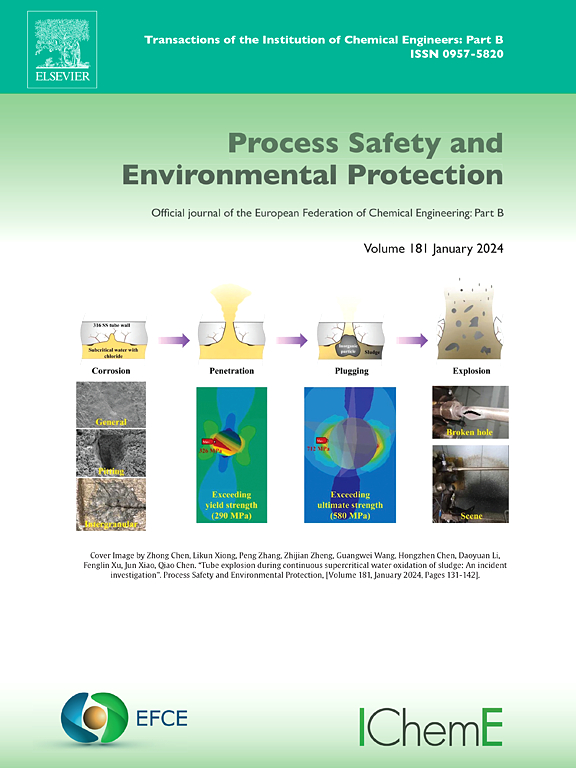Simultaneous removal of phosphate and hydroquinone using Fe3Ce1Ox(CA)/H2O2 Fenton-like system
IF 7.8
2区 环境科学与生态学
Q1 ENGINEERING, CHEMICAL
引用次数: 0
Abstract
Phosphates and organic matter usually coexist in secondary effluent, adversely affecting the stable control of water quality. Therefore, achieving the simultaneous removal of phosphates and organic matter from water bodies is significant. This study reports an excellent Fe₃Ce₁Oₓ(CA) functional material synthesized via a simple one-step co-precipitation method for hydroquinone (HQ) degradation through a Fenton-like reaction while simultaneously adsorbing phosphate. Experimental results show that the Fe₃Ce₁Oₓ(CA) materials exhibit a 92 % HQ degradation efficiency and an 80 % phosphate adsorption efficiency. Systematic characterization confirms that the Fe–Ce synergistic effect enhances the Fe(II) content, significantly promoting H₂O₂ activation. Electron paramagnetic resonance and radical scavenger experiments reveal that ¹O₂, O₂•⁻, and •OH play essential roles in organic degradation, with •OH being the dominant reactive species. Introducing citric acid increases the Ce(III) content in the Fe–Ce bimetallic oxide composite, enhancing its phosphate adsorption performance. This material successfully achieves both HQ degradation and phosphate removal, and these findings suggest that the Fe₃Ce₁Oₓ(CA)/H₂O₂ system can potentially treat wastewater with combined organic and phosphate pollution. This approach, which achieves multifunctionality in water treatment by regulating the composition of environmental functional materials, enhances the practical application potential of such materials.
fe3ce10ox (CA)/H2O2类fenton体系同时去除磷酸盐和对苯二酚
二级出水中磷酸盐和有机物通常共存,对水质的稳定控制产生不利影响。因此,实现水体中磷酸盐和有机物的同时去除具有重要意义。本研究采用一步共沉淀法合成了一种性能优异的Fe₃Ce₁Oₓ(CA)功能材料,通过类芬顿反应降解对苯二酚(HQ),同时吸附磷酸盐。实验结果表明,Fe₃Ce₁Oₓ(CA)材料对HQ的降解效率为92 %,对磷酸盐的吸附效率为80 %。系统表征证实了Fe - ce协同效应提高了Fe(II)含量,显著促进了H₂O₂活化。电子顺磁共振和自由基清除剂实验表明,¹O₂、O₂•⁻和•OH在有机降解中起重要作用,其中•OH是主要的反应物质。柠檬酸的引入提高了Fe-Ce双金属氧化物复合材料中Ce(III)的含量,增强了其对磷酸盐的吸附性能。该材料成功地实现了HQ的降解和磷酸盐的去除,这些研究结果表明,Fe₃Ce₁Oₓ(CA)/H₂O₂体系有可能处理有机和磷酸盐混合污染的废水。这种方法通过调节环境功能材料的组成实现了水处理的多功能性,增强了环境功能材料的实际应用潜力。
本文章由计算机程序翻译,如有差异,请以英文原文为准。
求助全文
约1分钟内获得全文
求助全文
来源期刊

Process Safety and Environmental Protection
环境科学-工程:化工
CiteScore
11.40
自引率
15.40%
发文量
929
审稿时长
8.0 months
期刊介绍:
The Process Safety and Environmental Protection (PSEP) journal is a leading international publication that focuses on the publication of high-quality, original research papers in the field of engineering, specifically those related to the safety of industrial processes and environmental protection. The journal encourages submissions that present new developments in safety and environmental aspects, particularly those that show how research findings can be applied in process engineering design and practice.
PSEP is particularly interested in research that brings fresh perspectives to established engineering principles, identifies unsolved problems, or suggests directions for future research. The journal also values contributions that push the boundaries of traditional engineering and welcomes multidisciplinary papers.
PSEP's articles are abstracted and indexed by a range of databases and services, which helps to ensure that the journal's research is accessible and recognized in the academic and professional communities. These databases include ANTE, Chemical Abstracts, Chemical Hazards in Industry, Current Contents, Elsevier Engineering Information database, Pascal Francis, Web of Science, Scopus, Engineering Information Database EnCompass LIT (Elsevier), and INSPEC. This wide coverage facilitates the dissemination of the journal's content to a global audience interested in process safety and environmental engineering.
 求助内容:
求助内容: 应助结果提醒方式:
应助结果提醒方式:


